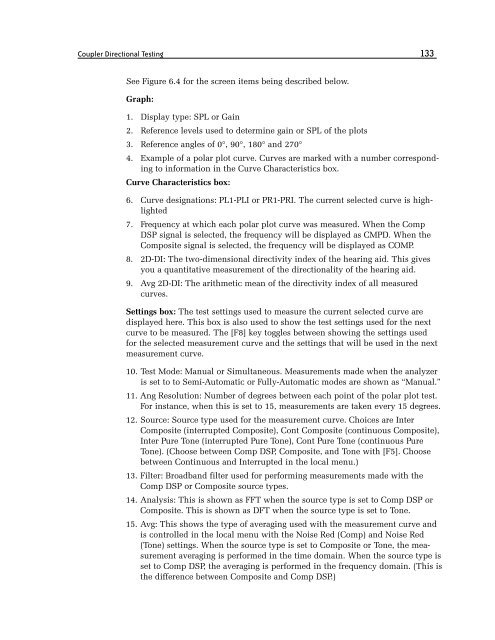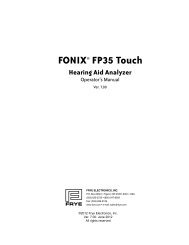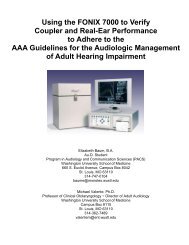FONIX® 8000 - Frye Electronics
FONIX® 8000 - Frye Electronics
FONIX® 8000 - Frye Electronics
Create successful ePaper yourself
Turn your PDF publications into a flip-book with our unique Google optimized e-Paper software.
Coupler Directional Testing 133<br />
See Figure 6.4 for the screen items being described below.<br />
Graph:<br />
1. Display type: SPL or Gain<br />
2. Reference levels used to determine gain or SPL of the plots<br />
3. Reference angles of 0°, 90°, 180° and 270°<br />
4. Example of a polar plot curve. Curves are marked with a number corresponding<br />
to information in the Curve Characteristics box.<br />
Curve Characteristics box:<br />
6. Curve designations: PL1-PLI or PR1-PRI. The current selected curve is highlighted<br />
7. Frequency at which each polar plot curve was measured. When the Comp<br />
DSP signal is selected, the frequency will be displayed as CMPD. When the<br />
Composite signal is selected, the frequency will be displayed as COMP.<br />
8. 2D-DI: The two-dimensional directivity index of the hearing aid. This gives<br />
you a quantitative measurement of the directionality of the hearing aid.<br />
9. Avg 2D-DI: The arithmetic mean of the directivity index of all measured<br />
curves.<br />
Settings box: The test settings used to measure the current selected curve are<br />
displayed here. This box is also used to show the test settings used for the next<br />
curve to be measured. The [F8] key toggles between showing the settings used<br />
for the selected measurement curve and the settings that will be used in the next<br />
measurement curve.<br />
10. Test Mode: Manual or Simultaneous. Measurements made when the analyzer<br />
is set to to Semi-Automatic or Fully-Automatic modes are shown as “Manual.”<br />
11. Ang Resolution: Number of degrees between each point of the polar plot test.<br />
For instance, when this is set to 15, measurements are taken every 15 degrees.<br />
12. Source: Source type used for the measurement curve. Choices are Inter<br />
Composite (interrupted Composite), Cont Composite (continuous Composite),<br />
Inter Pure Tone (interrupted Pure Tone), Cont Pure Tone (continuous Pure<br />
Tone). (Choose between Comp DSP, Composite, and Tone with [F5]. Choose<br />
between Continuous and Interrupted in the local menu.)<br />
13. Filter: Broadband filter used for performing measurements made with the<br />
Comp DSP or Composite source types.<br />
14. Analysis: This is shown as FFT when the source type is set to Comp DSP or<br />
Composite. This is shown as DFT when the source type is set to Tone.<br />
15. Avg: This shows the type of averaging used with the measurement curve and<br />
is controlled in the local menu with the Noise Red (Comp) and Noise Red<br />
(Tone) settings. When the source type is set to Composite or Tone, the measurement<br />
averaging is performed in the time domain. When the source type is<br />
set to Comp DSP, the averaging is performed in the frequency domain. (This is<br />
the difference between Composite and Comp DSP.)
















